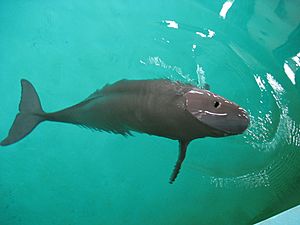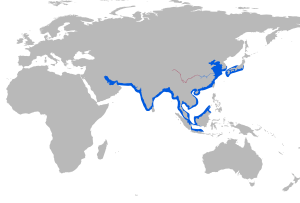Narrow-ridged finless porpoise facts for kids
Quick facts for kids Narrow-ridged finless porpoise |
|
|---|---|
 |
|
| Narrow-ridged finless porpoise | |
| Conservation status | |
| Scientific classification | |
| Genus: |
Neophocaena
|
| Species: |
asiaeorientalis
|
| Subspecies | |
|
|
 |
|
| For both finless porpoise species | |
The narrow-ridged finless porpoise (Neophocaena asiaeorientalis) is a special type of porpoise. It was recently recognized as its own species by the IUCN. These porpoises live in the western Yangtze River in China. They also live in the East China Sea, Yellow Sea, and around Japan.
There are two main groups, called subspecies. One is the Yangtze finless porpoise (N. a. asiaeorientalis). The other is the East Asian finless porpoise (N. a. sunameri). After the Yangtze river dolphin disappeared, and with their own numbers dropping fast, the Chinese government gave these porpoises a very high protection status. This means they are a National First Grade Key Protected Wild Animal. Big groups like the World Wildlife Fund (WWF) and IUCN are working with China to help them survive.
Contents
Where Do Finless Porpoises Live?
There are two main groups of narrow-ridged finless porpoises. The Yangtze finless porpoise lives only in the Yangtze River. The East Asian finless porpoise lives along the coasts of mainland China. You can find them near Chongming Island and the Penghu Islands. They also live along the coast of Vietnam, including Halong Bay.
The Matsu Islands are thought to be their northernmost home. The porpoises living there are smaller than the Indo-pacific finless porpoise. These two different types of finless porpoises can be found in the Matsu region.
What Do Finless Porpoises Look Like?
As their name suggests, finless porpoises do not have a tall dorsal fin on their back. Instead, they have a low, narrow ridge. This ridge is covered in thick skin and has tiny bumps called tubercles. Their forehead is also quite steep compared to other porpoises.
They have between 15 and 21 teeth in each jaw. They usually have fewer teeth than other porpoises. However, this is not a perfect way to tell them apart.
Size and Color
Finless porpoises can grow up to 2.27 m (7 ft 5 in) long. They can weigh up to 72 kg (159 lb). Most are a bit smaller than this. Adult porpoises are usually more than 1.55 m (5 ft) long. They weigh between 30–45 kg (65–100 lb). Their flippers are fairly large, making up about 20% of their total body length.
Adults are usually a plain, light grey color. Some might have lighter spots around their mouth. Others might have darker spots in front of their flippers. Baby porpoises from the central and eastern groups are mostly black. They have grey around their dorsal ridge. They turn fully grey after about four to six months. However, baby porpoises from the western group are a light creamy grey. They get darker as they grow older.
Inside Their Bodies
Scientists have studied the bodies of finless porpoises quite well. The small bumps (tubercles) on their back ridge have many nerve endings. These might help them sense things around them. Their hearing system is also very good. It has many nerve fibers that help their ears and brain communicate quickly.
Their eyesight is not very strong. This is because the Yangtze River is often cloudy. They have smaller eye lenses and fewer nerves for vision compared to the Indo-pacific finless porpoise. It is believed their vision is a bit better than the Yangtze river dolphin.
Their bones are light, making up only 5% of their total weight. They have between 58 and 65 bones in their spine. About half of these are in their tail. The first three neck bones are joined together. This makes their neck less flexible but helps them stay stable in the water. They have 10 to 14 pairs of ribs. Like all porpoises, they have spade-shaped teeth. These teeth are perfect for catching small fish and shrimp. Their body structure allows them to jump out of the water. They can even stand on their tails, a behavior called "tail stands".
Their nose passage has nine or ten air sacs. These sacs can seal off all air inside the passage. They also have other special sacs behind these. The windpipe is short, with only four rings of cartilage. Their stomach has three parts.
Reproduction and Life Cycle
Finless porpoises are thought to become adults around six years old. They usually have only one baby at a time. The mother carries the baby for about one year. She then nurses it for over six months.
How Humans Affect Finless Porpoises
Threats to Their Survival
Fishing Dangers
Sometimes, finless porpoises get caught by accident in fishing nets. This is called Bycatch. It is a big reason why the Yangtze finless porpoise numbers are still going down. Illegal fishing and dangerous nets, like gillnets, are common in the Yangtze River. Finless porpoises often live in the same areas where gillnets are used. This makes them very likely to get tangled and drown.
However, a recent study by the IUCN suggests that fewer porpoises might be dying from getting caught in nets now. This is because their population has already dropped a lot. So, gillnets might not be the main reason for their decline anymore.
Conservation Efforts
In 2014, only 505 porpoises were left in the main part of the Yangtze River. Their numbers were very low in some areas. While many endangered animals see their decline slow down, the porpoise's population drop was actually getting faster. From 1994 to 2008, their numbers fell by about 6% each year. But from 2006 to 2012, the population dropped by more than half! From 1976 to 2000, their numbers went down by almost 70%. A 2012 survey by the World Wildlife Fund showed the decline was even faster, at 13.7% per year.
Good news! By 2017, the number in the Yangtze had gone up to 1,012. Thanks to ongoing protection efforts, porpoises have been seen again in places like Nantong. They were rarely seen there in recent years.
Most of the reasons for this population drop are linked to China's huge industrial growth since 1990. This led to more shipping, more pollution, and harm to the environment. Building dams on the river and illegal fishing also played a part. To protect the species, China's Ministry of Agriculture made it a "National First Grade Key Protected Wild Animal." This is the strictest protection by law. It means it is illegal to harm a porpoise.
In the Tian-e-Zhou Oxbow Nature Reserve, protection measures have helped. The porpoise population there grew from 5 to 40 in 25 years. The Chinese Academy of Science's Wuhan Institute of Hydrobiology is working with the World Wildlife Fund. They want to make sure this subspecies has a future. They have moved five porpoises to another safe area, the He-wang-miao oxbow.
Five protected nature reserves have been set up in areas where many porpoises live or die. In these areas, patrolling and harmful fishing gear are now banned. Scientists are also studying porpoise biology. This helps them learn how to protect the species through breeding programs in special centers. The Baiji Dolphinarium was started in 1992. It allows scientists to study how finless porpoises behave and reproduce. They look at things like changes in hormones and breeding habits.
Living in Zoos and Aquariums
Finless porpoises have been kept in captivity in Japan, China, and Indonesia. In Japan, 94 porpoises have been kept in total. Eleven have been in China, and at least two in Indonesia. Japan has three places set up for breeding them. There have been five recorded births there. Sadly, three babies died soon after birth. But two survived for several years.



